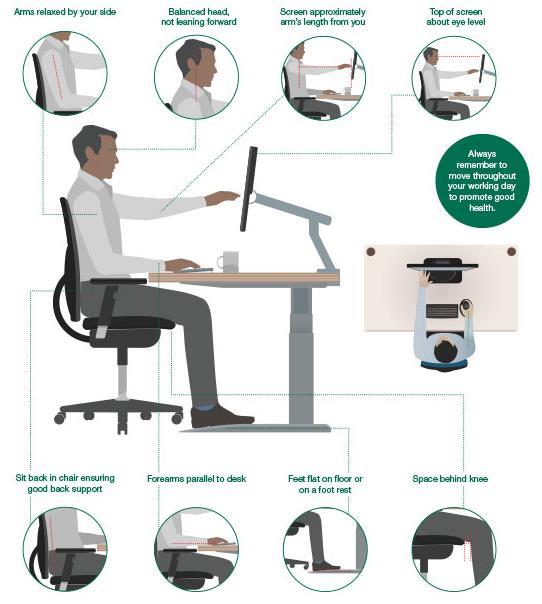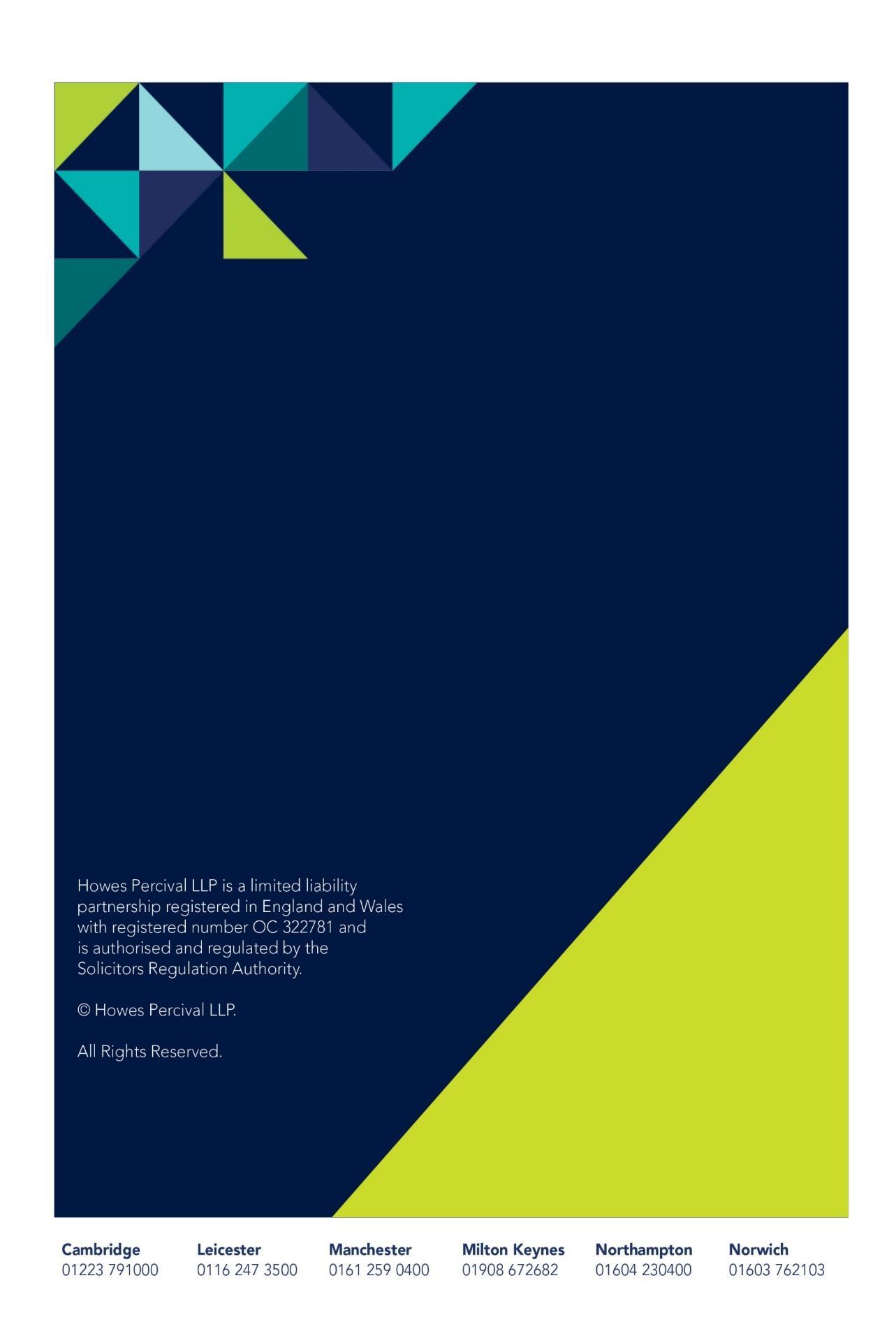

What's in this guide?
Introduction
The importance of DSE

4)
5) 6) 7) 8) 9)
Display Screen Equipment Assessments
How to comply
The Importance of Posture
Learn the impact of good posture
Getting Comfortable at your Desk
Tips on how you can improve your workstation
Desk-ercise!
Useful links to videos and resources to keep you active while at your workstation
Need Some Help
Contact details of people who can assist you
Remember, Sit Safely!
Example of a safe workstation
Introduction
We are invested in you and your health & wellbeing and we have a duty of care to protect you from possible health risks associated with working with display screen equipment (DSE).


DSE refers to any device with an alphanumeric or graphic display screen. This includes desktop computers, laptops, phones and tablets. The Health and Safety (Display Screen Equipment) Regulations 1992 were drawn up (and amended in 2002) to protect DSE users: people who use DSE every day for more than an hour at a time. This guide is to help you understand why it is important to complete a DSE assessment and provide support on how you can improve your working environment.
We also have useful videos and resources on the Learning Management System for you to use, please click here to access.

Display Screen Equipment Assessments…
To ensure we provide you with the correct support, we require you to undertake a DSE assessment when you first start at Howes Percival LLP and every year subsequently to ensure you have the right support in place. We would also recommend that an assessment is undertaken if your health or working conditions change.

By undertaking a DSE assessment, it will help you evaluate your current workstation and highlight any areas to improve your working environment.
Workstations that are not set up correctly may result in musculoskeletal injuries, including neck, shoulder, back & arm pains, fatigue and eyestrain. So, to maintain performance levels and safeguard your health and wellbeing, it is important to under take a DSE assessment.
To complete the Howes Percival LLP DSE Assessment, please click below:
Once completed Ros Hills, Facilities and Health & Safety Manager, will review and be in touch should you require any further support

The Importance of Posture…
The following points outline the effects on posture of not setting up your workstation correctly.

• Impacts your productivity. Sitting in an upright position and ensuring your screens/laptop is set up at the correct height energises you while slouching will make you feel more fatigued.

• Slouching is also bad for your breathing. Slouching can often be down to not having a correctly adjusted chair and not having your laptop set up at the correct height. Bad breathing can have an effect on the workings of the nervous system which can lead to increased stress levels.
• Sitting in an upright position and looking straight ahead allows you to breathe more easily and also makes you feel a lot better which in turn can decrease stress levels hugely.
• Having a poor posture has been known to have a very poor effect on mood. Those who sit for extended periods of time without a correct workstation setup show higher levels of depression.
Getting Comfortable at Your Desk…
The following guidance can help you prepare your desk to ensure a safe working setup.
Sitting Comfortably
• Try not to slouch, keep the curve in the lower back
• Adjust the chair/back rest to support the lower back
• Forearms should be approximately horizontal and the user’s eyes should be the same height as the top of the screen.
• Sit right back in the chair to gain proper support

• Remove obstructions that prevent upright postures
• Organise the workstation to allow upright postures
• Take regular breaks (5 minutes every hour)
Upper Body
• Align hands with the forearms, work with straight wrists
• Use a footrest if the seat height is too high
• Rest the upper body whenever routine allows
• Avoid arm and wrist activities during work breaks
Using a Mouse
• Position the mouse within easy reach, so it can be used with a straight wrist.
• Sit upright and close to the desk to reduce working with the mouse arm stretched.
• Move the keyboard out of the way if it is not being used.
• Support the forearm on the desk, and don’t grip the mouse too tightly.
• Rest fingers lightly on the buttons and do not press them hard.
Getting Comfortable at Your Desk…CONTINED
Reading the Screen
• Adjust the height of the screen to minimise head/neck movement

• Make sure individual characters on the screen are sharp, in focus and don’t flicker or move. If they do, the DSE may need servicing or adjustment.
• Adjust the brightness and contrast controls on the screen to suit lighting conditions in the room.
• Make sure the screen surface is clean.
• When setting up software, choose text that is large enough to read easily on screen when sitting in a normal comfortable working position.
• Select colours that are easy on the eye (avoid red text on a blue background, or vice versa).
Changes in Activity
• Breaking up long spells of DSE work helps prevent fatigue, eye strain, upper limb problems and backache. Organised or scheduled rest breaks may sometimes be a solution.
Click here to learn more about how to set your desk up appropriately.
Desk-ercise!
If you are interested in some desk exercises, take a look at the following videos to help guide you.
• Click here for desk yoga
• Click here for other desk exercises
• Click here for 3 stretches to prevent pain and improve posture
How we can help…
We are here to help you. If you have any questions relating to DSE, the assessment or your personal situation, please see the contact details of people who can help you below.
Have a question about the survey or how to complete it? Please contact Ros Hills on 01603 580090 or via email at ros.hills@howespercival.com

Need support with equipment in the office? Please contact your Office Manger or Office Lead:
• Cambridge – Debbie Hayes
• Leicester – Lyndsay Jordan
• Manchester – Jon Flude
• Milton Keynes - Deb Haye Davison
• Northampton – Jon Flude
• Norwich – Ros Hills
If you would like to talk about a personal situation – please get in touch with your People lead for your area or email the People Team at peopleteam@howespercival.com
Remember to sit comfortably!
Below is an imagine to help guide you on how to safely work at your desk to promote a healthier, happier you.


Notes:



